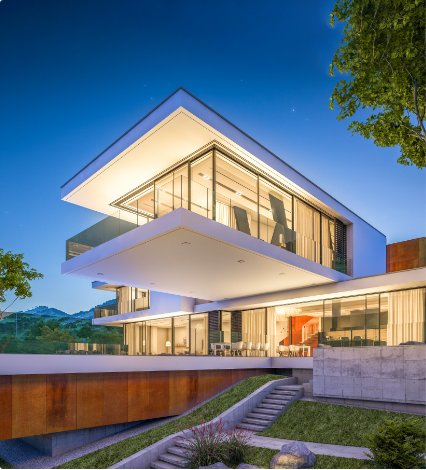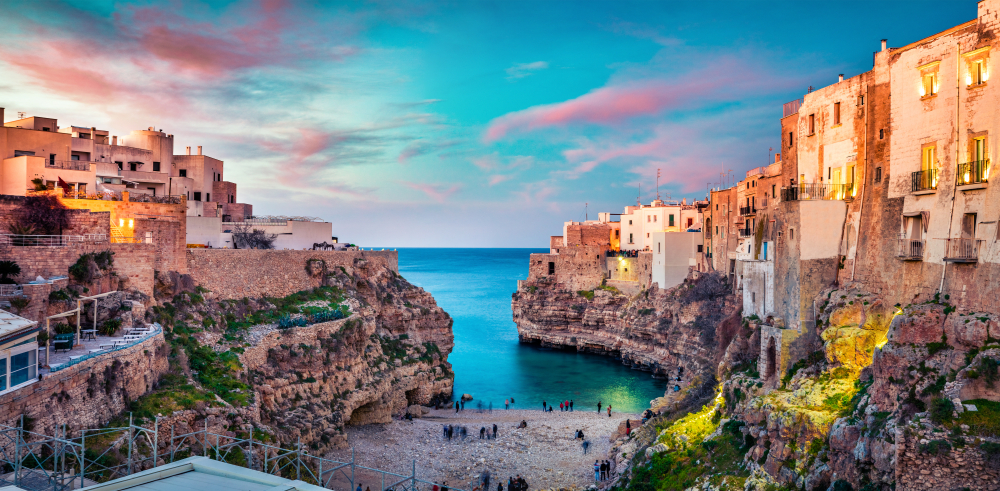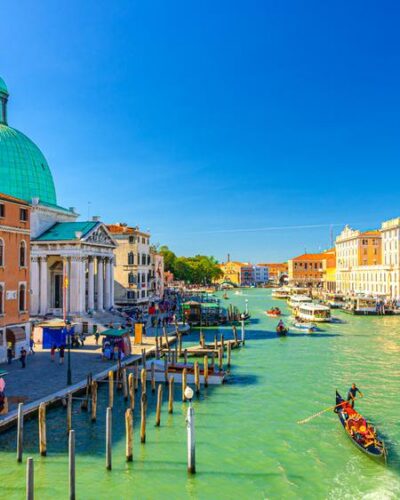Italy is a European country that has strongly influenced the development of Western culture. Located along the eastern Mediterranean Sea, its outline resembles a ‘boot.’
There are 20 regions of Italy, all with distinct histories, flavors, customs, and local dialects. 5 of these are independent regions in Italy with unique administrative status.
These autonomous zones include:
- Friuli-Venezia Giulia
- Sardinia
- Sicily
- Trentino-Alto Adige (Südtirol)
- Valle d’Aosta
Abruzzo

Abruzzo is Europe’s greenest region, with over half of the area dedicated to green spaces and reserves. Its capital, L’Aquila, sits in the foothills below the Gran Sasso, the highest peaks in the Apennine range.
There are many things to do in Abruzzo. Visitors can swim at Pescara’s Adriatic beaches or tour the capital city of L’Aquila, which is full of beautiful churches. Abruzzo’s national parks are popular for hiking and fishing in summer and skiing and sledding in winter.
Basilicata

Basilicata, a mostly mountainous region, sits in the instep of Italy’s boot. It is best known for the small town of Matera, which has been named a UNESCO World Heritage Site. Within the city are numerous 13th-century rock churches and beautiful frescos. And nearby is the Sassi, a cave complex that houses Casa Grotta di Vico Solitario – a museum with period furniture and artisan tools.
Basilicata, also known as Lucania, dates back to the 5th century B.C. Basilicata is bordered by three regions: Campania, Puglia, and Calabria.
Calabria

Calabria is a little-known region, often skipped for more glamorous nearby cities. But those who pass Calabria miss the 485 miles of legendary beaches. In fact, Calabria is third in Italy, with the most coastline.
Another prominent location in Calabria is The Museo Archeologico Nazionale in Reggio, Calabria, home to the Riace Bronzes, two of Italy’s most important ancient sculptures.
On the coast of Calabria are the narrow Straits of Messina. This two-mile stretch connects the Tyrrhenian Sea with the Ionian Sea and separates Sicily from Italy’s mainland.
Campania

The region of Campania has it all. It is the ninth largest region in Italy bordered by Lazio, Molise, Abruzzo, Puglia, and Calabria.
Naples, Campania’s capital, is an enigmatic town dominated by history – while the still-active Mount Vesuvius looms in the distance. Pompeii and Herculaneum, two ancient cities Vesuvius destroyed by ash and lava, lie nearby.
From the shore of Naples, one can see the Phlegrean Islands – Capri, Procida, and Ischia. Capri faces the UNESCO site of Costiera Amalfitana, also known as the Amalfi Coast. This spectacular coastline is dotted with vineyards and colorful cliffside houses.
As we move southward, the town of Paestum houses Ionic ruins.
And just north of Naples is the town of Caserta, home to the UNESCO site of Reggia di Caserta Royal Palace and the Vallo di Diano National Park.
In addition to these locations, Compania is home to six World Heritage Sites by UNESCO, including the Historic Centre of Naplex and the Santa Sofia complex in Benevento.
Emilia-Romagna

Emilia-Romagna is a region known for its culinary influences. The area is the birthplace of prosciutto, Parmigiano, balsamic vinegar, pasta, and bologna.
Bologna, the portico-lined capital of Emilia-Romagna, is home to the oldest university in the world, founded in 1088 A.D.
In addition to Bologna’s porticoes and Renaissance buildings, the nearby cities of Modena, Ravenna, and Ferrara all host UNESCO Heritage Sites. The Torre Civica Cathedral and Piazza Grande in Modena, the Early Christian Monuments of Ravenna and Ferrara’s Po Delta.
Centrally located in Italy, Emilia-Romagna is bordered by six other regions: Tuscany and Le Marche to its south and Lombardy and Veneto to its north.
Friuli-Venezia Giulia

Friuli-Venezia Giulia is Italy’s easternmost region with a decidedly Central European flair. One of five autonomous zones, Friuli-Venezia Giulia, is bordered by Veneto to its west, Austria to the north, Slovenia to its east, and the Adriatic Sea to the south.
Friuli-Venezia Giulia’s main cities tend to incorporate the language and style of its border countries, creating a unique culture and environment.
Trieste

Trieste is Italy’s easternmost city, a critical seaport, and Friuli-Venezia Giulia’s capital. Established in 1382, Trieste was part of the Hapsburg Empire for over 500 years. The port was the largest on the Adriatic — supporting world-class trade.
Udine

Udine province is a remote area often overlooked. However, the range of museums and extraordinary architecture is worth the side trip.
Prominent in the town is an art museum with works by the Baroque painter Caravaggio and the famed Tiepolo, who frescoed the Archiepiscopal Palace. And San Daniele prosciutto, considered the finest ham in Italy, is produced nearby.
Udine is another part of Italy recognized by UNESCO for numerous World Heritage sites, including the Patriarchal Basilica of Aquileia and the Cividale del Friuli.
Lazio

Lazio, Italy’s ninth-largest region, including five provinces, is known for its numerous archaeological sites and as home to Italy’s capital, Rome.
Traveling from Rome is easy. The country’s largest city is about 30 minutes to an hour from many spectacular beaches.
Rome’s southern archipelago includes the Pontine Islands. The islands consist of the trendy Ponza island and the wilderness reserves of Ventotene and Santo Stefano. These latter islands were once prisons from the Roman era through World War II.
Nearby Tivoli is home to two UNESCO World Heritage Sites.
The first is Hadrian’s Villa, Villa Adriana, a sprawling complex of 2nd-century ruins. The second is the Villa d’Este, a 16th-century estate famous for its terraced gardens and over 100 fountains.
Another ancient Roman site is only 30 minutes from Rome – Ostia Antica.
Once an ancient seaport, the site features a whole campus of ancient Roman ruins, an amphitheater, and mosaic tiles. Ostia Antica was abandoned when the sea silted and dried.
Liguria

The small region of Liguria is home to Genoa and La Spezia, sleepy nearby towns made famous by Shakespeare and acclaimed for their perfect Dolce Vita or sweet way of life. The area is best known as the Cinque Terre or Five Lands. These five colorful ancient seaside villages are set on the craggy Italian Riviera coastline and connected by the Sentiero Azzurro, a cliffside hiking trail.
Also in Lingua, southeast of Genoa is the small fishing village of Portofino on the Italian Riviera. Portofino is a favorite destination for shopping and relaxation as trendy boutiques and seafood restaurants fringe its Piazzetta. From the town square, one can walk to Castello Brown, a 16th-century fortress and museum with art exhibitions overlooking the Ligurian Sea.
Lombardy

Known as Lombardia in Italian, Lombardy was once ruled by the Germanic kingdom of the Longobards in the 5th century.
Seventeen hundred years later, this vibrant city is considered the richest of Italy’s regions, with its capital, Milan, the center of fashion and finance. Energetic and lively, the town of Malan is home to the famed Navigli Canal District, where eclectic bars and trendy restaurants create an unforgettable night scene.
Milan is also an ancient place, resting on the ruins of Mediolanum and serving as the Roman capital for a brief time.
The Basilica of Saint Ambrose, Circa 882 A.D., is a remnant from the 1st century. As Milan’s patron saint, Sant’Ambrogio remains in the church’s underground crypt.
Northeast of Milan is the small town of Bergamo. This Romanesque town is perfect for a day trip and is filled with architectural finds and churches. The walled city is accessible by a funicular.
Lombardy is also home to several lakes. Lake Como is the third-largest lake in Italy, after Lake Garda and Lake Maggiore.
Although Lombardy is well connected with public transportation, pan-European railways, and highways, there is always plenty to see and do as this Italian region has ten UNESCO sites.
UNESCO Heritage Sites in Lombardy
- Santa Maria Delle Grazie housing “The Last Supper” by Leonardo da Vinci, Milan
- Crespi d’Adda
- Mantua (Mantova) and Sabbioneta
- Monte San Giorgio
- Prehistoric Alpine Pile Dwellings
- Rhaetian Railway in the Albula / Bernina Landscapes
- Rock Drawings in Valcamonica
- Sacri Monti of Piedmont and Lombardy
- San Salvatore-Santa Giulia in Brescia (Longobard Site)
- Santa Maria Foris Portas, Torba Tower and Castelseprio (Longobard Site)
Le Marche

Pronounced lay Mar-kay in Italian, Le Marche combines rugged hills, dense forests, and perfect beaches.
The Marchigiani were the region’s tax collectors.
Urbino is a walled city within Marche, famous for the 15th-century turreted Palazzo Ducale. Inside the palace, the National Gallery of the Marche features paintings by Raphael and the Elder. Next to the neoclassical cathedral is the Museo Diocesano Albani, with religious artifacts dating back to the 13th century.
Le Marche is bordered to its north, west, and south by the regions of Tuscany, Umbria, Emilia-Romagna, Abruzzo, and Lazio. A unique blend of Italy, visitors will find Tuscany’s sophistication combined with Umbria’s tranquility in Le Marche.
The climate makes this a year-round destination, but the summer and fall festivals bring the region to life.
Molise

Once part of Abruzzi, Molise is gently considered the country’s most unassuming region. The picturesque landscapes and quaint villages serve as the iconic vision of sleepy Italian life.
Piemonte

Piemonte borders four regions of Italy, Switzerland, and France. Elegant and sophisticated, the region of Piemonte is home to the royal House of Savoy and the home of Fiat. Turin, the region’s capital city, is located a few miles from the Alps. This area is a winter skiing destination with some of the highest mountains in the Gran Paradiso National Park.
Many extraordinary historical collections can be found within Turin, including UNESCO’s 22 Residences of the Royal House of Savoy.
Turin is also home to The Shroud, a delicate Christian relic. The city hosts Museo Egizio, which houses one of the oldest Egyptian collections in the world. And this quaint city is also credited as the Italian cinema.
Piedmont and Turin are credited with developing creamy hazelnut chocolate – gianduiotto. And yes, this is where Nutella was born.
Puglia

Puglia is the heel of Italy’s well-fashioned boot covering Italy’s southeast coast. Translated as Apulia, it is an important agricultural area growing wheat and olive groves.
Sardinia

The Mediterranean’s second largest island, Sardegna, is a land of white cliffside homes, shepherds, and firmly held beliefs. Sardinia is famous for the medieval Castello that looms over the town. The capital city of the tiny Italian island is Cagliari.
Central to the town is the 13th-century Cagliari Cathedral. The Museo Archeologico Nazionale di Cagliari displays bronzes and artifacts from the Nuragic age to the Byzantine era.
Sicily

Sicily is a small island with a long history of trade and commerce. Breathtaking churches fill the streets of the capital Palermo, and Greek ruins pepper the hills of Taormina.
Trentino Alto Adige

Trentino Alto Adige, also known as Südtirol, was settled by the ancient Germanic tribes. The region’s capital, Bolzano, is in a vineyard-covered valley in the Italian Alps. The Dolomite Mountains, made world-famous by the discovery of the Neolithic mummy Ötzi the Iceman, dominate the region.
The Museum of Archaeology sits at the center of this medieval town. Nearby, visitors can find the 13th-century Mareccio Castle and the Duomo di Bolzano cathedral, the Romanesque and Gothic Duomo di Bolzano cathedral.
The town’s tram offers easy access to the Dolomite Mountains for hikers and backpackers.
Tuscany

Fortified castles and pristine vineyards fill the rolling hills of Italy’s most notable region, Tuscany. This western Italian region is known for its tranquil landscapes and mesmerizing sunsets.
Florence’s regional capital was the birthplace of banking, art, and Italian democracy.
Pisa, a small western coastal town in the region, is about an hour’s train ride from Florence. Pisa is a historical and artistic treasure famous for Bonanno Pisano’s Romanesque structure, the Leaning Tower of Pisa.
Siena is a small Gothic town in Tuscany’s central region known for its fan-shaped, bricked main square, Piazza del Campo. The city’s 17 iconic districts extend outward from the piazza like spokes on a wheel.
Umbria

Picture quaint medieval hill towns, cobblestone streets, rolling green farmland, and dense forests. Umbria borders Tuscany and Lazio, making it ideal for day trips and weekend escapes from Florence and Rome.
The late spring and early fall climate are the best times to visit Umbria and its capital city, Perugia.
There are numerous festivals, such as Calendimaggio, a type of medieval game that encompasses the town of Assisi.
The largest festival, Festa Dei Ceri, is a medieval Candle Festival. Each year, costumed racers carry wooden candles up Gabbrio’s Mount Ingino.
Valle d’Aosta

Known for unparalleled skiing, Aosta Valley is a French forward autonomous region nestled between Piemonte, France, and Switzerland.
Veneto

Veneto gave birth to the Venetian Republic, La Serenissima, which dominated the Adriatic Sea from the 8th to the 18th centuries – over a thousand years.
Veneto combines the canals of Venice and the Veronese arena — an operatic venue. Veneto is also home to the world’s oldest botanical gardens and the awe-inspiring architecture of the Saint Anthony of Padua Basilica.
Nearby Verona is also home to Lake Garda, Benaco, the largest lake in Italy. And this eminent Italian region produces the world’s prosecco supply from the hills of Conegliano.
Veneto has eight UNESCO World Heritage Sites, including Padova Urbs Picta, the Padua City of Paintings, and Venice’s Lagoon.
Featured Image Credit: Andrew Mayovskyy













